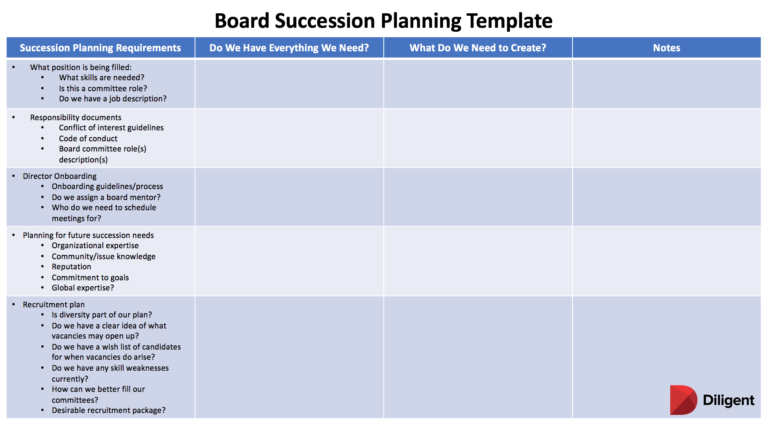Board Succession Planning Template
When it comes to board succession planning, astute boards are also designing matrices that reflect both current and future organizational and board needs. Your lead committee and the board itself will want to consider whether the current board composition provides an adequate candidate pool for future board leadership. If so, would the appointment of a new chair or vice chair from within the current ranks create any committee expertise gaps to be filled? If it’s been a while since your board succession planning template was last revised, it may not reflect the need for technology strategy expertise. It’s inevitable, though, that the board can benefit from having a director with the knowledge and experience required to provide meaningful oversight of the organization’s goals and risks associated with artificial intelligence (AI), customer relationship management (CRM), cybersecurity and more. Similar cases may be made for succession planning that targets expertise in environmental, social and corporate governance (ESG) or social media and communications qualifications. Are any of these areas of expertise reflected within your current succession planning documents? It’s also helpful to assess whether board culture has shifted to the point that appointment renewals are not assumed to be a given – at least not without positive evaluations or performance reviews, and confirmation that such incumbents’ expertise isn’t maintained at the expense of other expertise for which there may be a more pressing need.

According to the 2018 United States Spencer Stuart Board Index, 22% of S&P 500 boards added two or more new directors during the 2018 proxy year, and another 35% added one new director during the same period. Spencer Stuart noted that, of the nine S&P 500 boards that added four or more independent directors in 2018, most of them made the additions in light of either business transformations or activists. While the average addition per board worked out to just shy (0.88) of one new director per board, the 2018 proxy year saw the 485 S&P 500 boards appoint a total of 428 new independent directors. Twenty-five and a half percent of those incoming directors brought financial expertise to their new boards, and 17% of the 428 were aged 50 or younger upon selection. Taking a closer look at those next-gen directors, 53% of them are women and more than a third of the next-gen directors have technology or telecommunications sector backgrounds. Spencer Stuart identified technology experience, digital experience and then social media as the three top skills or qualifications of the younger directors. It may be unsurprising to note that the percentage of newly appointed directors who were active or retired CEOs, chairs, vice chairs, presidents or COOs has declined; it’s gone from 47% in 2008 to 35.5% in 2018. A third of all those 428 new independent directors are serving on their first public company boards, which may have an impact on board culture and board education needs.
Responsibility of the Corporate Secretary
What can you as a corporate secretary or other governance professional take away from this snapshot of other boards’ practices? If your board is already reviewing its succession planning on a regular basis, you may find that your board matrix reflects current succession planning practices. If this isn’t the case, and whatever your sector, you may want to recommend or initiate some updates to your board’s practices. Does your matrix template adequately reflect the governance needs associated with the organization’s strategic plan? Your lead committee will want its planning to reflect any strategic updates (opportunities and risks), as well as the most recent environmental scan. Your lead committee will update the board competency matrix to reflect current and future organizational needs. Once the template is updated, you can insert a list of directors, leadership roles and term dates. While still relatively simple, matrices have evolved; you can readily find samples online. On completion, the matrix will serve to identify gaps. Following board approval of the matrix and recruitment recommendations, board succession planning will see identification and assessment of external prospects.Planning For Leadership Positions
What about succession planning for leadership positions on the board? You can establish a simple table listing key roles: board chair, vice chair(s) and then each of the committee chair roles. Alongside each role, insert the incumbent’s name and the date on which that director’s term concludes. From this point, the committee can identify prospective successors in a series of subsequent years. Your lead committee may project only two years out, or five. This might be affected by your sector and whether external parties have authority over your board appointments and terms, which may make longer-term projections challenging. If your committee has already identified prospective leadership successors, either formally or informally, it can populate the table with those names. It’s worth considering, with each review, whether previously identified names continue to make sense. It’s not unheard of for either the board’s needs or a potential successor’s availability to change. You ideally have board-approved position descriptions or terms of reference (TOR) for each of your board’s leadership roles. If not, you may wish to recommend establishing them. If you do have such documents, your lead committee would be well served to invite interested prospective successors to review such “job descriptions” and provide self-assessments of their related leadership skills or competencies. Your lead committee could also review board evaluation results as part of this process. Throughout the process, your board succession planning can benefit from Enterprise Governance Management (EGM). EGM is the application of technical tools and resources to meet your board’s needs. Diligent’s Board Assessment Tool enables you to create and customize the evaluations your board undertakes. You can securely distribute and collect evaluations, with the lead committee (or whichever committee the board deems appropriate) accessing evaluation reports as appropriate for board succession planning. Your lead committee can also turn to the portal for ready access to the board’s succession plan, matrices and related resources.Wrapping Up Planning
It’s not likely that all prospective successors will be role-ready at the point in time when they’re been identified for a future leadership role. With the leadership role description and a self-assessment in hand, the lead committee and each individual can identify specific forms of development to be undertaken. This may take the form of mentorship, conferences, workshops, opportunities to lead in other capacities, formal education or a combination of these approaches. This also supports board culture and engagement, and it will require that the board is adequately financially resourced. If board succession planning doesn’t already have a place on the board’s work plan or agendas, you’d do your board a service by recommending its inclusion. We tend to do what we document. If your board wants to support not only effective succession planning and board engagement, but also transparency, it may approve and document its practices within a policy. The policy can contain links to role descriptions and information on selection criteria/leadership competencies, self-assessment processes, development plans, and evaluation and onboarding processes. The next step is building in regularly scheduled reviews of this policy and the associated budget, templates and forms. Is your board up for it?





